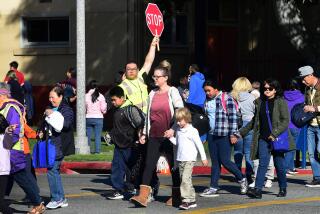Young Children at Risk Attempting to Cross Streets
- Share via
WASHINGTON — Running across a sleepy lane to play with neighborhood kids or crossing a couple of streets on the way to school hardly seems life-threatening for a school-age child. But more youngsters in kindergarten through third grade die in pedestrian accidents than perish riding bikes or in cars.
Each year, about 1,500 pedestrians under age 14 are killed in the United States. Being hit by traffic is the second leading cause of death, trailing only cancer, among children ages 5 to 9.
Despite those sobering statistics, one-third of 2,464 parents questioned in a recent survey sometimes allowed their kindergarten-age children to cross residential streets by themselves and first-graders to walk alone to school. Yet 94% of those same parents said they did not think the average 5- to 6-year-old child can reliably cross streets alone.
“Children under the age of 8 or 9 do not have the developmental skills needed to cross traffic and do it safely every time. They really should not cross streets alone,” said Dr. Frederick Rivara, chief author of the study and director of Seattle’s Harborview Injury Prevention and Research Center.
“Nobody thinks their child is average developmentally. But the fact is that most children are average,” said Rivara, whose study involved parents from a “fairly typical” Seattle suburb.
Most parents surveyed correctly thought a child’s risk of being run over by a car was greater than the risk of drowning or being burned in a house fire. But most incorrectly assumed that a child had a greater chance of being hurt in a car or bike accident than crossing a street on foot.
About 98% of the parents reported they taught their children how to cross streets, and nearly two-thirds said the youngsters had been taught pedestrian safety at school. About 40% said they thought kindergarten-age children should be able to cross busy streets that do not have traffic lights.
Results of the survey, published recently in the journal Pediatrics, indicate that parents--and urban planners--must be better educated about the risk that traffic poses to youthful pedestrians.
“You hate to make life more restrictive than it already is for kids. What we really need to do is change the way we approach this,” said Rivara, who is a pediatrics professor at the University of Washington medical school.
According to the National Safety Council, about 70% of pedestrian deaths and injuries among children age 5 through 9 occur when the youngsters are crossing or entering streets. Nearly 8% happen when children are playing in roads, 3% occur while they are walking along roadways and the rest are linked to other activities.
In residential areas, frequent risks involve children darting into a street at mid-block or walking in front of traffic after buying a treat from an ice cream truck or other food vendor, the safety council says.
One way to protect children without curtailing their freedom might be to follow what the Swedes do and build housing in patterns that allow children to get to parks and community centers without having to cross roads, Rivara said.
In addition, he said school safety courses in the early grades should put their emphasis on telling children not to cross streets alone, rather than giving them relatively complex information about how to use traffic signals or cross busy intersections.
Until such changes are made, parents should take the time to walk young children across streets or make certain they are in the company of responsible older children, Rivara said.
More to Read
Sign up for Essential California
The most important California stories and recommendations in your inbox every morning.
You may occasionally receive promotional content from the Los Angeles Times.











